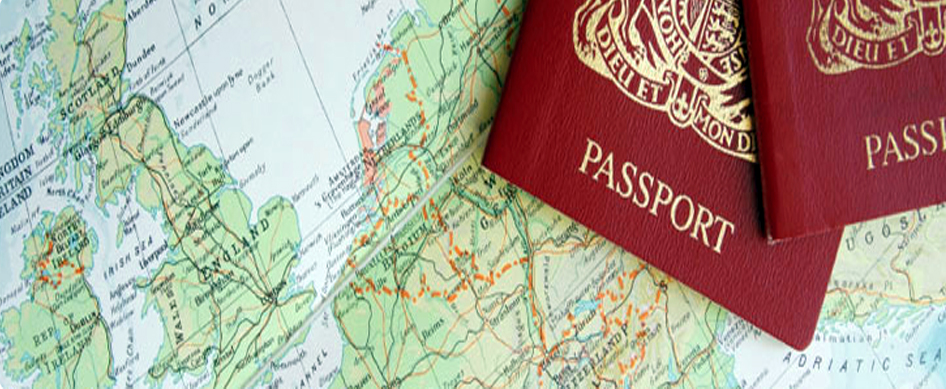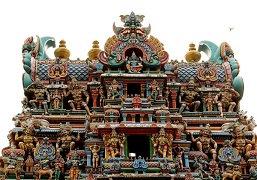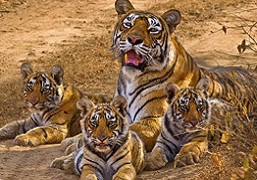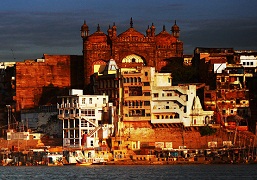India is the seventh largest country in the world. Northern India contains the snow-bound peaks and deep valleys of the Himalayas and the vast Gangetic Plain, which separates the Himalayan region from the southern peninsula and stretches from the Arabian Sea to the Bay of Bengal. South of the plains, the land rises up into a triangular-shaped plateau known as the Deccan. The plateau is bordered by the Eastern and Western ghats, ranges of hills, which run parallel to India’s eastern and western coasts and separate the fertile coastal strips from the interior.
Time Zone: India is 5 hrs 30 minutes ahead of GMT (Greenwich Mean Time) in the winter months India is 4 hrs 30 minutes ahead of GMT.
Climate: Climate varies greatly, from the arid deserts of Rajasthan to the cool highlands of Assam, allegedly the wettest place on earth. But basically India has a three-season year – the hot, the wet and the cool. The heat starts to build up on the northern plains around April and cools off by September. The monsoon rains begin around June and end August. India’s northern cities start getting cool by October and become crisp at night in December. In the far south, it never gets very cold, the temperatures are comfortably warm rather than hot.
Health Information: We advise you to read the health requirements and discuss health precautions for your exact travel itinerary with a qualified health professional at least six (6) weeks before you depart. No vaccinations are currently required for entry into either India or Nepal when arrival is directly from North America or an Asian or European country. However, please read the following information on the conditional requirement for yellow fever vaccination.
Immunization against polio, tetanus and typhoid is recommended. Visitors arriving from yellow fever area require valid vaccination certificates. Malaria is endemic in certain parts of India; consult a doctor for anti-malaria prescription. Additionally carry any anti-mosquito cream or lotion for local application. Modern hospitals exist in all major cites of India but visitors are advised to travel with sufficient quantities of prescription drugs.
Passport and Visa Information: Each traveller must be in possession of a valid, signed passport that will remain valid for six (6) months beyond the completion of his/her trip.
Visas: All foreign nationals require visas for India. NOTE: You must obtain a MULTIPLE-ENTRY visa for India if you are entering the country more than once on your itinerary. If entering India more than once during a tour a double or multiple entry visas must be obtained. Indian visas cannot be issued on arrival. All foreign national require visas for Nepal.
Citizens of countries other than the United States should check with their booking agents for requirements pertaining to their citizenship, as entry requirements can vary.
In compliance with current requirements, passenger names on airline reservations must exactly match the names on their passports.
Please be aware that it is the traveller’s responsibility to obtain all documents that are necessary for admittance to the countries visited on his/her itinerary.
Arrival and Custom Information: Please be advised that regulations at most points of international arrival do not permit passengers to be met inside secured passenger areas (such as the Customs area). Passengers can only be met outside of the airport building. On arrival in India, you will be required to complete a Currency Declaration Form.
Airport Charges: Airport departure tax applies at different levels for neighbouring countries and these may or may not be included in the cost of your air ticket. This can be rechecked before departure from your ticketing/travel agent. Please be advised that airport departure taxes are subject to change without notice.
Reconfirmation of Flights: When you arrive in India, your Crown Tours representative will collect your airline tickets so that departure flights can be reconfirmed. Flight reconfirmation is essential in India, and failure to do so is likely to result in cancelled reservations.
Electricity: Electricity 220 AC. Socket sizes vary widely: take a universal adaptor.
Languages: Popular languages are Hindi and English, plus 16 main languages and over 700 dialects are spoken in India.
Photography: If you are taking photographs of local people, always ask their permission beforehand. Your driver / guide will assist you in this and will possibly help you agree on a modeling fee. Do not take photographs of any official buildings, such as military installations, airports, railway stations, boarder posts or roadblocks.
Baggage Information: There are several different sets of baggage allowance regulations in effect for international and regional flights. Baggage allowances can vary depending on which airline(s), class of service, and routing is used. Despite the information given here, you are urged to check with your booking agent for the exact baggage regulations pertaining to your specific itinerary.
Please be advised that baggage limits are adhered to very strictly on both international and domestic flights. Most domestic carriers have more restrictive baggage limitations than international carriers. On domestic flights, the baggage allowance is 30 kilograms (66 lbs.) per person for those traveling in economy class and 40 kilograms (88 lbs.) per person for those traveling in executive class.
In case of a small plane being used for travel within India or Nepal, the maximum baggage allowance varies between 15 (33 lbs) to 20 kilograms (44 lbs.) per person. Any baggage in excess of airline limitations may be subject to substantial freight charges by the airline. In addition, do not pack valuable items (such as your camera and jewelry) in checked baggage. Canned foods, knives, scissors, or other sharp objects that may be considered potentially dangerous should not be packed in your hand luggage.
Guides: Trained English speaking guides are available at fixed charges at all important tourist centres. French, Italian, Spanish, German, Russian and Japanese speaking guides are available at most of the important cities. Since the Language speaking guides are limited in numbers, at times during peak season it may be difficult to get them. Request to give enough notice for language speaking guides.
Export of Antiques: Antiquities, which include sculpture, painting or other works of art and crafts, illustrative of science, art, crafts, religion of bygone ages and of historical interest which have been in existence for not less than 100 years may not be exported out of India.
Manuscripts or other documents of scientific, historical, literary or aesthetic value in existence for not less than 75 years; art treasures, not necessarily antiquities but having regard to the artistic and aesthetic value cannot be exported out of India.
For further clarification on the antiquity of an artefact, the tourists can contact the authorities and get information on the Acts and Rules governing Antiquities and Art Treasures Act, 1972.
Currency: The Indian Rupee (Rs), divided into 100 paise (p). There are no restrictions on the amount visitors can bring into India. Travelers carrying more than US$ 5000 in cash and US$ 10,000 in traveler’s cheque are required to fill in a currency declaration form.
Most hotels and large shops accept credit cards but smaller properties and game lodges do not. Only change money at official banks and hotels and keep your receipts, which is required in the event of your changing the Indian currency to your own currency .






